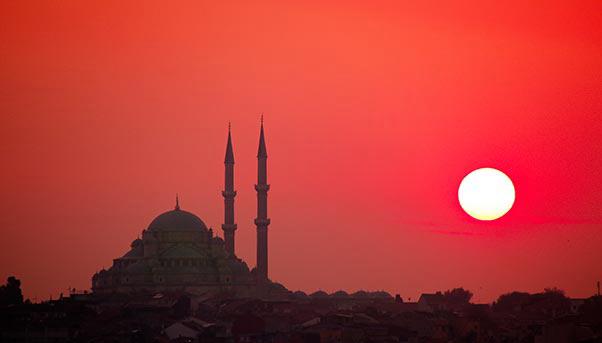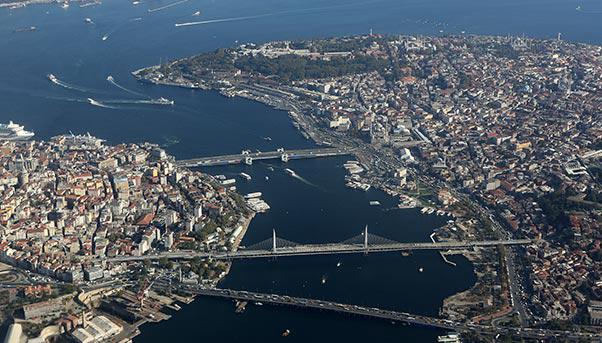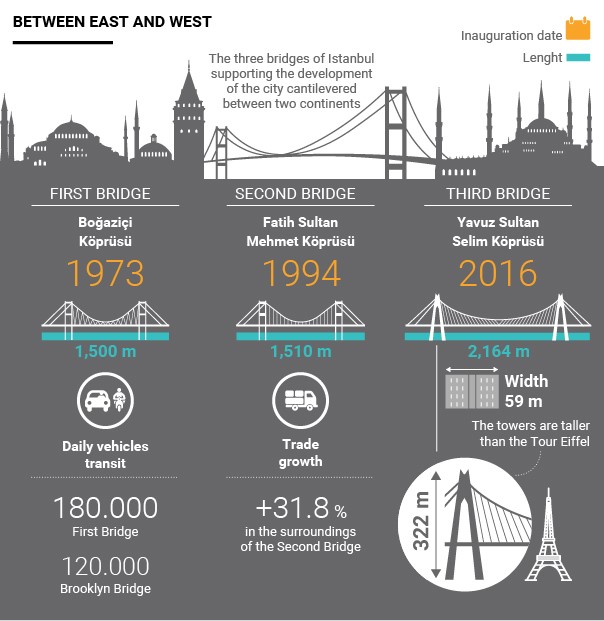
At night, the lights of Istanbul make the sea glitter, drawing fishermen back to shore where they later crowd the Galata Bridge to return home in the Ortaköy neighborhood on the European side of the Bosphorus Strait.
They walk along narrow streets, leaving behind the neo-Baroque mosques built near the water’s edge. Above them stretches the Fatih Sultan Mehmet Bridge, joining the neighborhood with the other shore of the city, as if stitching a land split in two, one side European, the other Asian.
This second bridge, built across the strait between 1985 and 1994, is 1,090 metres long but it completes a highway that runs 247 kilometres from Kinali in Europe to Kazanci in Asia.
Like the other bridges that straddle the strait, the Fatih Sultan Mehmet is a link between two worlds – a link that is both functional and cultural given Istanbul’s unique position.
The desire to bridge the divide between Europe and Asia dates back more than 400 years before Christ. The ancient Greek historian Herodotus wrote of Darius the Great as the first to envision a crossing over the Bosphorus. He had hundreds of ships align themselves to create a pontoon bridge. His successor, Xerxes I, was also said to have used boats to form a crossing to allow his soldiers to cross in his campaign to invade Greece. In his case, however, he chose a spot to the south in the Dardanelles Strait.
Centuries would pass before a permanent structure was to be built to join the two worlds. On Nov. 5, 1973, the first bridge was opened on occasion of the celebration of the 50th anniversary of the birth of the republic in the presence of one million people. Stretching 1,500 metres and hovering 64 metres above sea level, the Boğaziçi Köprüsü was Turkey’s response to the demands of a city undergoing a demographic boom.

Its opening came at a time when tens of thousands of people were abandoning the eastern rural lands of Anatolia to begin a new life in Istanbul. The bridge opened the possibility for those who settled on the Asian shore to work on the European side where opportunities were more plentiful and the economy more dynamic. This daily commute was so common that it was possible to cross the bridge by foot for several years until car traffic became so intense that it was eventually prohibited.
About 180,000 vehicles cross the Boğaziçi Köprüsü every day, compared with the 120,000 that use the Brooklyn Bridge in New York. This traffic flow is a perfect indicator of the enormous economic and demographic growth that Istanbul has experienced in recent decades. Its population has risen from two million in 1970 to more than 13 million. And the wealth that these city residents produce has grown by an annual average of 4.5% since 1950, with its residents paying 40% of the total tax receipts collected by the country.
Although the second bridge, Fatih Sultan Mehmet, was built by a consortium with Salini Impregilo to lend support to this growth, it also encouraged it: seven years since its inauguration, trade among the surrounding areas have risen 31.8%, while the number of hectares adjacent to the structure to witness urbanization increased from 340 to 42,260.

With Istanbul’s population expected to reach 16 million by 2020, the demographic pressure is such that a third bridge was built. In August 2016, it was inaugurated by Turkish President Recep Tayyip Erdogan.
His government also oversaw the $1.24 billion construction of the Avrasya, a 14.6-kilometre tunnel below the Bosphorus. Opened at the end of 2016, it receives 100,000 vehicles every day, reducing their commuting time to 15 from 100 minutes.
The construction of the third bridge and the tunnel seem to be a natural progress of the 1937 urban project devised by French architect Henri Prost for Mustafa Kemal Ataturk, the republic’s first prime minister. The project foresaw the opening of great boulevards, the restoration of historic monuments, the creation of public spaces like Gezi park and many other initiatives that set the foundations of modern living in the city.
The bridges over the Bosphorus belonged to this vision, which came to inspire even artists like Orhan Pamuk, Turkey’s famed writer.
«I have spent my life in Istanbul, on the European shore, in the houses looking towards the Asian shore. Living by the water with a view of the opposite shore ceaselessly reminded me of my place in the world. Then one day a bridge connecting the two shores of the Bosphorus was built. When I went up on the bridge and surveyed the landscape, I realized it was still better and still more lovely to see the two shores at once. I felt like a bridge between two shores was the best thing to be. Speaking to each shore without completely belonging to either; this unveiled the finest scenery of all», he once said.

